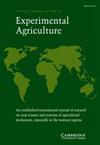优化尼日利亚北部小农玉米农场不同施氮量下基于播种密度的管理决策
IF 1.9
4区 农林科学
Q1 Agricultural and Biological Sciences
引用次数: 4
摘要
在本研究中,利用2016年和2017年雨季来自尼日利亚苏丹(SS)和北几内亚(NGS)稀树草原60个农民田间的数据,对CERES-Maize模型进行了校准和评估。试验包括以三种不同的播种密度(2.6、5.3和6.6株m - 2)在农民田间播种10个玉米品种,并对比农艺和营养管理历史。所有品种和农业生态的物候、生长和产量数据的归一化均方根误差(RMSE)低(≤15%)、修正d指数高(> 0.6)、模型效率高(>0.45),都证明了模型在年份和地点的预测与校准和评估的观测数据接近。在年份和地点以及校准和评估练习中,在观测和模型模拟的谷物产量、生理成熟天数、地上生物量和收获指数之间发现了非常好的一致性。使用邦库尔(代表SS)和扎里亚(代表NGS)的长期(26年)天气记录进行了两个单独的情景分析。SS采用早、超早品种,NGS采用中、晚品种。情景分析结果表明,在推荐施氮量(90 kg N ha - 1)条件下,早熟和超早熟品种的播种密度最高可达8.8株m - 2。在NGS中,中后期品种在密度为6.6株m−2时,施用120 kg N ha−1,观察到产量响应。最高意味着货币回到土地(美元1336.1公顷−1)模拟场景的8.8 m−2和90公斤N ha−1,而最高回报的劳动(957.7美元公顷−1)模拟了场景为6.6 m−2和90公斤N公顷党卫军−1。在门店,每公顷货币回报最高植物种植密度为6.6 m−2与应用程序的120公斤N,而回到劳动植物播种密度最高的5.3 m−2的N施肥。长期模拟的结果预测,通过增加尼日利亚玉米带的播种密度,在不施用超过推荐用量的氮肥的情况下,土地和劳动力的经济回报将增加。本文章由计算机程序翻译,如有差异,请以英文原文为准。
Optimizing sowing density-based management decisions with different nitrogen rates on smallholder maize farms in Northern Nigeria
Abstract In this study, the CERES-Maize model was calibrated and evaluated using data from 60 farmers’ fields across Sudan (SS) and Northern Guinea (NGS) Savannas of Nigeria in 2016 and 2017 rainy seasons. The trials consisted of 10 maize varieties sown at three different sowing densities (2.6, 5.3, and 6.6 plants m−2) across farmers’ field with contrasting agronomic and nutrient management histories. Model predictions in both years and locations were close to observed data for both calibration and evaluation exercises as evidenced by low normalized root mean square error (RMSE) (≤15%), high modified d-index (> 0.6), and high model efficiency (>0.45) values for the phenology, growth, and yield data across all varieties and agro-ecologies. In both years and locations and for both calibration and evaluation exercises, very good agreements were found between observed and model-simulated grain yields, number of days to physiological maturity, above-ground biomass, and harvest index. Two separate scenario analyses were conducted using the long-term (26 years) weather records for Bunkure (representing the SS) and Zaria (representing the NGS). The early and extra-early varieties were used in the SS while the intermediate and late varieties were used in the NGS. The result of the scenario analyses showed that early and extra-early varieties grown in the SS responds to increased sowing density up to 8.8 plants m−2 when the recommended rate of N fertilizers (90 kg N ha−1) was applied. In the NGS, yield responses were observed up to a density of 6.6 plants m−2 with the application of 120 kg N ha−1 for the intermediate and late varieties. The highest mean monetary returns to land (US$1336.1 ha−1) were simulated for scenarios with 8.8 plants m−2 and 90 kg N ha−1, while the highest return to labor (US$957.7 ha−1) was simulated for scenarios with 6.6 plants m−2 and 90 Kg N ha−1 in the SS. In the NGS, monetary return per hectare was highest with a planting density of 6.6 plants m−2 with the application of 120 kg N, while the return to labor was highest for sowing density of 5.3 plants m−2 at the same N fertilizer application rates. The results of the long-term simulations predicted increases in yield and economic returns to land and labor by increasing sowing densities in the maize belts of Nigeria without applying N fertilizers above the recommended rates.
求助全文
通过发布文献求助,成功后即可免费获取论文全文。
去求助
来源期刊

Experimental Agriculture
农林科学-农艺学
CiteScore
2.50
自引率
6.20%
发文量
29
审稿时长
24 months
期刊介绍:
With a focus on the tropical and sub-tropical regions of the world, Experimental Agriculture publishes the results of original research on field, plantation and herbage crops grown for food or feed, or for industrial purposes, and on farming systems, including livestock and people. It reports experimental work designed to explain how crops respond to the environment in biological and physical terms, and on the social and economic issues that may influence the uptake of the results of research by policy makers and farmers, including the role of institutions and partnerships in delivering impact. The journal also publishes accounts and critical discussions of new quantitative and qualitative methods in agricultural and ecosystems research, and of contemporary issues arising in countries where agricultural production needs to develop rapidly. There is a regular book review section and occasional, often invited, reviews of research.
 求助内容:
求助内容: 应助结果提醒方式:
应助结果提醒方式:


